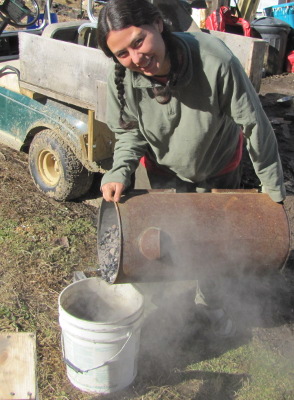
How to activate biochar
 Traditional terra
preta,
on which current biochar research is based, was made by mixing
charcoal, bones, pottery shards, human waste, and other trash together
in a pit, and recent studies have shown that it's best to mimic this by
adding some sort of high nitrogen fertilizer to your charcoal before
applying it to the garden. Applying biochar to the soil without
adding nitrogen to it first can sometimes stunt your plants for a short
time, a bit like mixing fresh wood chips into the soil, since
microorganisms have to use up nitrogen to break down the carbon.
Adding manure, compost, or urine
to the biochar counteracts that initial
decline in plant growth and may also tempt microorganisms to move into
their biochar condos faster.
Traditional terra
preta,
on which current biochar research is based, was made by mixing
charcoal, bones, pottery shards, human waste, and other trash together
in a pit, and recent studies have shown that it's best to mimic this by
adding some sort of high nitrogen fertilizer to your charcoal before
applying it to the garden. Applying biochar to the soil without
adding nitrogen to it first can sometimes stunt your plants for a short
time, a bit like mixing fresh wood chips into the soil, since
microorganisms have to use up nitrogen to break down the carbon.
Adding manure, compost, or urine
to the biochar counteracts that initial
decline in plant growth and may also tempt microorganisms to move into
their biochar condos faster.
If you're in a hurry for great soil, an alternative method of
activating the biochar is working it into your compost pile. A
few studies have suggested that biochar helps speed up the composting
process (probably by increasing microorganism populations), and when
you put the biochar-compost on your garden, the biochar will already be
full of hard-working microbes.
Finally, don't forget to soak your biochar before application.
This isn't technically part of the activation process, but everything
will go more smoothly if you fill those pores with water. And if
you do decide to grind
your charcoal, pre-soaking it is supposed to make biochar easier to
work with both during the grinding and application process.
| This post is part of our Biochar in the Backyard lunchtime series.
Read all of the entries: |
Want more in-depth information? Browse through our books.
Or explore more posts by date or by subject.
About us: Anna Hess and Mark Hamilton spent over a decade living self-sufficiently in the mountains of Virginia before moving north to start over from scratch in the foothills of Ohio. They've experimented with permaculture, no-till gardening, trailersteading, home-based microbusinesses and much more, writing about their adventures in both blogs and books.
Want to be notified when new comments are posted on this page? Click on the RSS button after you add a comment to subscribe to the comment feed, or simply check the box beside "email replies to me" while writing your comment.
